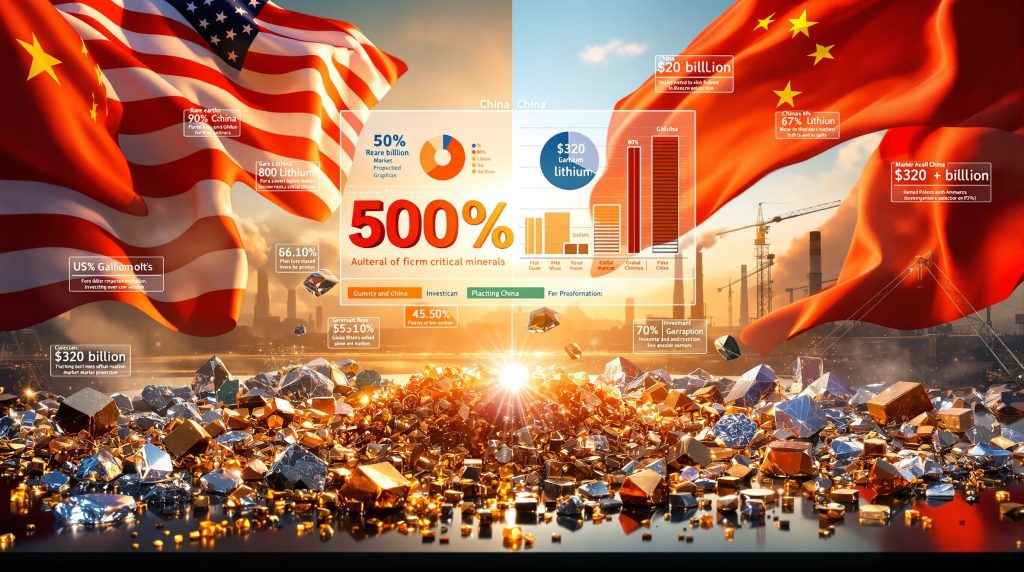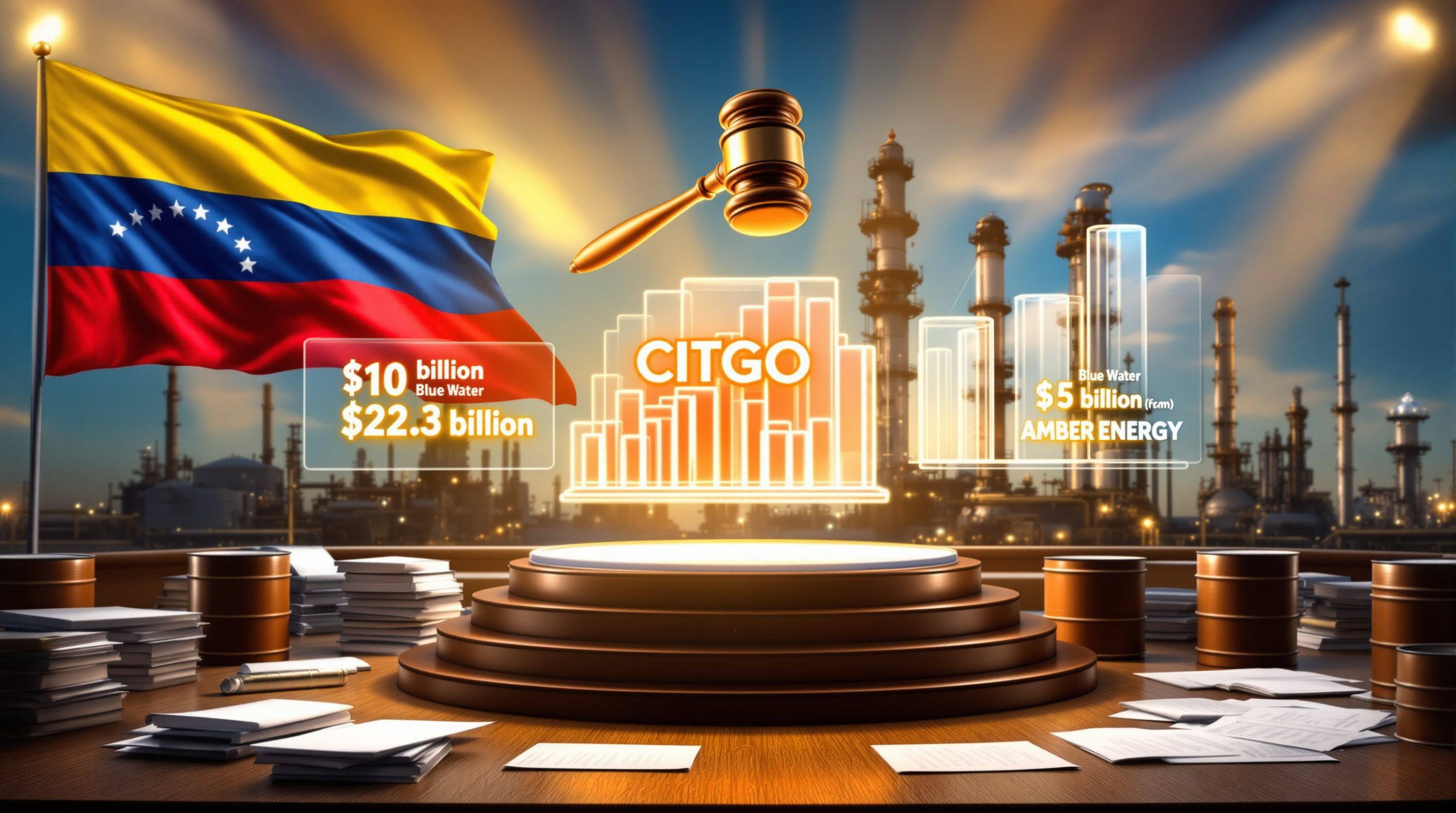The global competition for critical minerals has reached a pivotal moment where the US must outspend China on critical minerals to secure its strategic and economic future. These materials, essential for everything from smartphone batteries to military radar systems, represent the foundation of modern technological society. The U.S. Geological Survey identifies 50 mineral commodities as critical, defining them as essential to economic or national security while maintaining supply chains vulnerable to disruption.
The stakes could not be higher in this critical minerals energy security competition. The global critical minerals market, valued at approximately $182 billion in 2020, continues expanding rapidly as clean energy transitions accelerate worldwide. Electric vehicle production alone requires substantial quantities of lithium, cobalt, nickel, and graphite, while defense systems depend on rare earth permanent magnets for precision-guided munitions and electronic warfare equipment.
Understanding the Strategic Imperative Behind Critical Minerals Competition
Critical minerals encompass a diverse range of materials that share common characteristics: limited supply sources, difficult substitution, and essential applications across multiple industries. These materials include rare earth elements like neodymium and dysprosium, battery metals such as lithium and cobalt, and specialty materials like gallium and germanium used in semiconductor manufacturing.
Defense applications alone demonstrate the strategic importance of these materials. Modern military systems integrate rare earth elements throughout their design, from the permanent magnets in jet engines to the electronic components in satellite communications. A single F-35 fighter jet incorporates approximately 920 pounds of rare earth materials, illustrating the defense sector's dependence on secure supply chains.
The clean energy transition amplifies these requirements exponentially. Wind turbines utilise rare earth permanent magnets in their generators, while solar panels require silver and various specialty metals. Electric vehicles demand lithium-ion batteries containing multiple critical minerals, with projected demand growth far exceeding current production capacity across numerous material categories.
Defining Critical Minerals and Their Economic Impact
The implications for battery metals investment extend beyond simple market dynamics. These materials represent the backbone of emerging technologies that will define economic competitiveness for decades to come. Furthermore, the concentration of supply sources creates unprecedented vulnerabilities in global trade relationships.
China's dominance across critical mineral supply chains represents an unprecedented concentration of strategic resources under single-nation control. Current statistics reveal the extent of this dominance, with implications that underscore why the US must outspend China on critical minerals to maintain technological leadership.
China's Market Control Statistics That Demand Urgent Response
China's control over midstream processing represents a particularly strategic chokepoint, as raw materials from global sources often require Chinese facilities for refinement into usable forms. Even minerals mined in other countries frequently depend on Chinese processing infrastructure, maintaining Beijing's leverage over global supply chains.
The concentration creates vulnerabilities extending far beyond simple supply disruption risks. According to Mining.com, China's integrated approach to critical minerals development has created market positions that will require massive Western investment to challenge effectively.
| Material | China's Global Market Share | Strategic Significance |
|---|---|---|
| Rare earth processing | 85-90% | Defense systems, clean energy |
| Lithium battery supply chain | 75-80% | Electric vehicles, grid storage |
| Graphite processing | 90-95% | Battery anodes, steel production |
| Gallium production | 80% | Semiconductors, LED technology |
| Germanium production | 60% | Fiber optics, infrared systems |
The implications for national security are profound. Modern defense systems, from radar installations to guided missile systems, rely heavily on Chinese-controlled supply chains for essential components. Consequently, this dependence creates potential vulnerabilities in military readiness and technological capability maintenance during periods of geopolitical tension.
How Did China Achieve Near-Monopoly Status?
China's dominance in critical minerals results from decades of coordinated strategic planning, massive state investment, and aggressive market positioning. Understanding this development provides crucial insights into the scale of effort required to establish competitive alternatives.
China's approach began in the 1990s with recognition that controlling critical materials would provide significant geopolitical leverage in an increasingly technology-dependent global economy. State-owned enterprises received substantial subsidies and policy support to develop domestic mining and processing capabilities, often operating with environmental and safety standards that would be unacceptable in Western nations.
The Belt and Road Initiative, launched in 2013, extended this strategy globally through infrastructure investments exceeding $1 trillion across more than 150 countries. Many of these projects specifically targeted resource-rich regions in Africa, Latin America, and Central Asia, securing long-term supply agreements and ownership stakes in strategic mineral deposits.
What Financial Commitment Must the US Make to Compete Effectively?
Challenging China's critical minerals dominance requires financial commitments on a scale matching the strategic importance of these materials. Current U.S. investments, while significant, remain insufficient to meaningfully alter global supply chain dynamics within realistic timeframes. Moreover, establishing a critical minerals strategic reserve requires unprecedented coordination between government and industry.
The Department of Defense has allocated approximately $400 million through Defense Production Act Title III funding for rare earth and critical mineral projects since 2021. However, this amount pales in comparison to the estimated $50-100 billion required to establish competitive domestic processing capabilities across multiple mineral categories.
The U.S. International Development Finance Corporation has provided strategic investments, including approximately $105 million in financing to TechMet Ltd., a company focused on developing critical minerals projects outside Chinese control. TechMet has successfully raised $200 million in total capital, demonstrating private sector interest in strategic mineral investments when supported by government risk mitigation.
Cost Structure of Building Alternative Supply Chains
Establishing competitive critical minerals production outside China faces several cost disadvantages that government intervention must address. Environmental compliance costs increase operational expenses by 30-60% compared to Chinese operations, while labour cost differentials create additional challenges for Western facilities.
Scale disadvantages present another significant hurdle. New facilities lack the economies of scale achieved by mature Chinese operations serving global markets. Additionally, technology transfer costs add substantial capital requirements, as many processing technologies require licensing or development partnerships.
Price support mechanisms, such as government purchase agreements or production subsidies, may be necessary to make domestic processing economically viable during initial years of operation. The defense sector's willingness to pay premium prices for supply security provides one model, though broader industrial applications require more comprehensive approaches.
Which Strategic Partnerships Can Accelerate US Critical Minerals Independence?
International cooperation offers the most realistic pathway to reducing dependence on Chinese supply chains within reasonable timeframes. Strategic partnerships leverage existing capabilities, shared democratic values, and complementary resource endowments to create alternative supply networks.
The U.S.-Australia Climate, Critical Minerals and Clean Energy Transformation Compact, established in 2023, represents a framework for enhanced cooperation between natural allies. Australia's position as the world's second-largest rare earth producer, generating approximately 18,000-22,000 tonnes of rare earth oxides annually, provides a foundation for supply diversification.
Lynas Corporation exemplifies successful Australian-U.S. cooperation in critical minerals. The company operates Australia's Mt Weld mine and has received U.S. Department of Defense funding to establish rare earth processing capability in Texas. Lynas produced approximately 12,000 tonnes of neodymium-praseodymium products in fiscal year 2023, demonstrating commercial viability of non-Chinese rare earth supply chains.
African Resource Diplomacy Opportunities
Africa contains substantial reserves of critical minerals, particularly cobalt from the Democratic Republic of Congo and copper from the Zambian Copperbelt. However, Chinese companies and financial institutions have invested an estimated $60 billion in African mining projects between 2008-2020, establishing dominant positions across multiple countries and commodities.
The DRC contains approximately 48-51% of global cobalt reserves and produces roughly 70% of annual mine output, representing approximately 130,000 tonnes in 2023. Chinese companies, including China Molybdenum and Zijin Mining, control significant stakes in DRC cobalt production through direct ownership and financing arrangements.
Western engagement in African critical minerals requires alternative approaches to Chinese investment models. Rather than the infrastructure-for-resources arrangements favoured by Chinese companies, Western partnerships might emphasise technology transfer, environmental standards, and governance improvements that benefit local communities while securing resource access.
What Technologies and Innovations Can Reduce Dependence on Chinese Supply?
Technological innovation offers multiple pathways to reduce critical mineral dependencies through improved recycling, alternative materials development, and advanced processing techniques. These approaches require sustained research investment and policy support to achieve commercial viability.
Rare earth element separation represents one of the most technologically challenging aspects of critical minerals processing. Traditional solvent extraction methods require 20-30 processing stages and generate substantial waste streams, contributing to the cost disadvantages facing Western processors compared to Chinese facilities.
Current recycling rates reveal substantial improvement opportunities. Lithium-ion battery recycling currently achieves approximately 5% globally, while less than 1% of rare earth elements are recovered from end-of-life products. Advanced recycling technologies, including direct cathode recycling that preserves material structure, could significantly reduce primary mining requirements.
Alternative Material Development Programs
However, deep-sea mining challenges represent both opportunities and obstacles for critical minerals supply diversification. Polymetallic nodules on abyssal plains contain billions of tonnes of nickel, copper, cobalt, and manganese, but commercial extraction requires technological breakthroughs in remote operations.
Research into rare-earth-free technologies offers long-term solutions to supply chain vulnerabilities. Alternative approaches include ferrite-based permanent magnets with lower performance but reduced rare earth content, wound-rotor synchronous motors for electric vehicle applications without permanent magnet requirements, and sodium-ion batteries as potential lithium alternatives for stationary energy storage.
How Do Export Controls and Trade Restrictions Affect Global Markets?
China's strategic use of export controls demonstrates how resource dominance translates into geopolitical leverage. Understanding these mechanisms and their market impacts provides insights into the urgency of supply chain diversification efforts, particularly for the European CRM facility initiatives.
China announced export controls on gallium and germanium in July 2023, effective from August 2023, affecting materials essential for semiconductor manufacturing and defense applications. China produces approximately 80% of global gallium and 60% of global germanium, making these controls particularly impactful on global supply chains.
Market responses were immediate and substantial. Gallium prices increased approximately 25-30% in the months following the announcement, while supply chain managers globally scrambled to identify alternative sources or increase inventory positions. The controls demonstrated China's ability to create market disruption through administrative measures rather than direct trade warfare.
Historical Patterns and Market Mechanisms
The 2010-2015 rare earth export quota system provides a template for understanding China's export control strategies. During this period, rare earth oxide prices increased 500-1000% as global buyers competed for limited supplies. The price spikes stimulated non-Chinese rare earth mining projects globally, though many subsequently became uneconomical when prices normalised.
Export licensing requirements create uncertainty and administrative delays that extend beyond direct supply restrictions. Buyers typically respond by diversifying supply sources or increasing inventory levels, causing short-term demand spikes that amplify price volatility. Reuters reports that long-term effects may reduce Chinese market share as alternatives develop, but adjustment periods can extend over multiple years.
What Are the National Security Implications of Critical Minerals Dependence?
Critical minerals dependence creates multiple vectors for national security vulnerability, extending from direct military applications to broader economic security considerations that affect long-term strategic competitiveness. This reality reinforces why the US must outspend China on critical minerals to maintain national security.
Modern weapon systems integrate critical minerals throughout their design and manufacturing processes. Each F-35 fighter jet requires approximately 920 pounds of rare earth materials for various components, including permanent magnets in actuators, electronic systems, and sensor arrays. Naval systems depend on specialty alloys for submarine hulls and advanced radar systems requiring gallium and germanium semiconductors.
Supply disruption scenarios reveal cascading vulnerabilities across defense manufacturing. Extended delivery delays for critical materials could slow production of essential defense systems, while price volatility affects procurement budgets and long-term planning. Quality control issues with alternative suppliers could compromise system performance or reliability.
Economic Security Considerations
Beyond direct military applications, critical minerals dependence affects broader economic competitiveness in emerging technology sectors. The clean energy transition requires substantial quantities of lithium, cobalt, and rare earth elements, while semiconductor manufacturing depends on gallium, germanium, and various specialty materials.
Electric vehicle manufacturing represents a particularly visible example of supply chain vulnerability. Global automakers have experienced production delays and increased costs due to battery material shortages, demonstrating how critical minerals access affects industrial competitiveness. Companies lacking secure supply arrangements face strategic disadvantages in emerging markets.
Consequently, the economic implications extend to innovation and technological leadership. Industries dependent on critical materials may relocate production to regions with better supply access, potentially leading to technological knowledge transfer and reduced domestic manufacturing capability over time.
Which Investment Models Show Promise for Rapid Capacity Building?
Developing alternative supply chains requires innovative financing approaches that address the unique risks and timelines associated with critical minerals projects. Traditional market mechanisms often prove inadequate for strategic resource development, necessitating government involvement and creative partnership structures.
TechMet Ltd. exemplifies successful government-private cooperation in critical minerals development. The company has received approximately $105 million in financing from the U.S. International Development Finance Corporation while raising $200 million in total capital from private sources. This blended finance approach provides government risk mitigation while leveraging private sector efficiency and expertise.
Ukraine's lithium project bidding requires minimum investments of $179 million from winning bidders, demonstrating the capital intensity required for modern critical minerals development. Such projects benefit from government backing while requiring substantial private sector commitment and expertise.
International Consortium Development
Five Eyes intelligence alliance mineral cooperation offers frameworks for multinational critical minerals development. The United States, United Kingdom, Canada, Australia, and New Zealand share democratic governance, similar regulatory approaches, and established defense cooperation agreements that facilitate resource sharing arrangements.
EU Critical Raw Materials Act alignment creates opportunities for transatlantic cooperation in supply chain development. European Union initiatives to reduce Chinese dependence complement U.S. objectives, creating potential for coordinated investment and technology sharing across Western allies.
Furthermore, Japan-Australia-India trilateral partnerships demonstrate regional approaches to critical minerals security. These arrangements leverage complementary capabilities: Japanese technology and financing, Australian resources and mining expertise, and Indian manufacturing capacity and market access.
What Timeline Challenges Face US Critical Minerals Independence?
Developing meaningful critical minerals independence requires understanding and managing extended development timelines that span decades for comprehensive supply chain establishment. These timelines often exceed political planning horizons, creating challenges for sustained policy support and investment commitment.
Critical minerals mine development typically requires 10-15 years from initial discovery to commercial production. This timeline includes extensive exploration to define ore bodies, environmental impact assessments, regulatory permitting processes, infrastructure development, and construction of extraction facilities.
Environmental permitting represents a particular challenge in developed nations, where regulatory processes can extend 3-5 years or longer for major mining projects. While these processes ensure environmental protection and community engagement, they create significant delays compared to countries with less stringent requirements.
Processing Infrastructure Build-Out Requirements
Processing facility construction typically requires 5-7 years from initial planning to commercial operation, though complex chemical processing plants may take longer. Rare earth separation facilities represent particularly challenging projects due to technological complexity and environmental requirements.
Technology transfer and expertise gaps create additional timeline extensions. Many critical processing technologies remain concentrated in Chinese facilities, requiring Western companies to develop alternative approaches or negotiate technology licensing agreements. Independent development can add years to project timelines.
Additionally, capital intensity comparisons with Chinese facilities reveal substantial investment requirements for competitive operations. New Western facilities must incorporate modern environmental controls, safety systems, and automation technologies that add to construction costs and timelines while improving long-term operational efficiency.
How Can the US Measure Success in Critical Minerals Competition?
Establishing clear metrics for critical minerals security enables policy evaluation, resource allocation optimisation, and progress tracking toward strategic independence objectives. Effective measurement frameworks must balance short-term achievements with long-term strategic goals, particularly as the US must outspend China on critical minerals over extended periods.
Supply chain diversification metrics provide quantitative measures of reduced Chinese dependence. A target of 40% non-Chinese sourcing across critical materials would represent substantial progress from current baselines, though achievement timelines vary significantly by material category.
Domestic processing capacity benchmarks track infrastructure development progress. Metrics might include tonnage capacity for rare earth separation, lithium processing capability, and specialty alloy production volumes. These indicators provide tangible measures of industrial capacity development.
Economic and Security Return on Investment
Cost-benefit analysis of supply chain security must account for both economic and strategic returns on public investment. Economic benefits include job creation potential, with estimates suggesting 50,000 or more direct positions in expanded critical minerals industries, plus multiplier effects in supporting sectors.
Innovation spillover effects from critical minerals investments may generate broader technological benefits. Advanced processing techniques, recycling technologies, and alternative materials research contribute to overall industrial competitiveness beyond immediate supply security objectives.
In conclusion, the competition for critical minerals represents a defining challenge for American strategic and economic security in the coming decades. Success requires sustained commitment, innovative approaches, and coordination across government, industry, and allied nations to build resilient supply chains capable of supporting national objectives while reducing dependence on potentially hostile sources.
Looking to Capitalise on Critical Minerals Investment Opportunities?
Discovery Alert's proprietary Discovery IQ model provides instant notifications on significant ASX critical minerals discoveries, helping investors identify actionable opportunities in this strategically important sector before the broader market reacts. Explore Discovery Alert's discoveries page to understand how major mineral discoveries have generated substantial returns throughout history, then begin your 30-day free trial to secure your market advantage.




